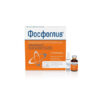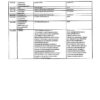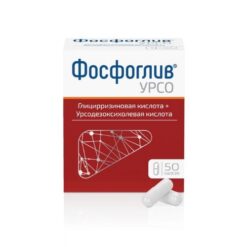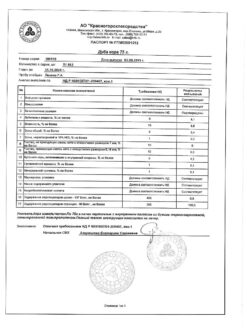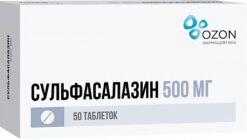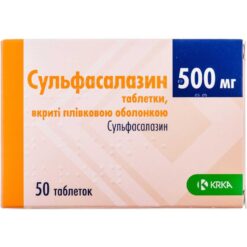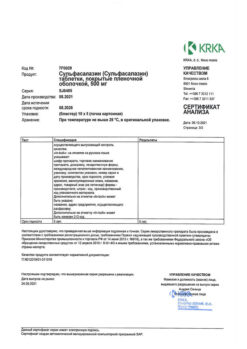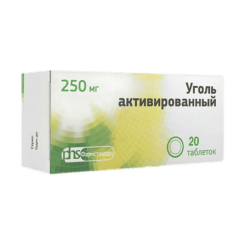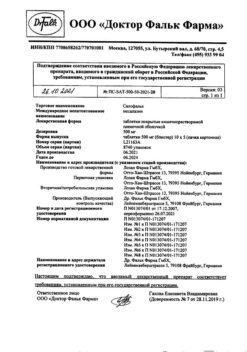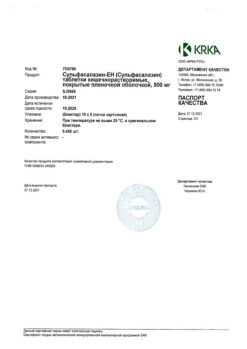No products in the cart.
Phosphogliv, lyophilizate. 500 mg+200 mg 2.5g 5 pcs
€51.08 €42.57
Description
Combined remedy.
It has membrane stabilizing, hepatoprotective and antiviral effect.
Phosphatidylcholine (the main component of phospholipids) is the main structural element of cell and intracellular membranes and can restore their structure and functions in case of damage, providing a cytoprotective effect.
Normalizes protein and lipid metabolism, prevents loss of enzymes and other active substances by hepatocytes, restores liver function, inhibits the formation of connective tissue, reducing the risk of liver fibrosis and cirrhosis.
Glycyrrhizic acid has anti-inflammatory effects, suppresses the reproduction of viruses in the liver and other organs by stimulating the production of interferons, increasing phagocytosis and increasing the activity of natural killer cells.
It has hepatoprotective effect due to antioxidant and membrane stabilizing activity. Glycyrrhizic acid potentiates the effect of endogenous glucocorticosteroids with anti-inflammatory and anti-allergic effect in non-infectious liver lesions.
In skin lesions due to the membrane stabilizing and anti-inflammatory action of the components limits the spread of the process and promotes the regression of the disease.
Pharmacokinetics.
Phosphatidylcholine
Binding primarily to high-density lipoproteins, phosphatidylcholine is delivered, particularly to liver cells. Half-life of the choline component is 66 hours, and of unsaturated fatty acids – 32 hours.
Glycyrrhizic acid
Glycyrrhizic acid, entering the systemic bloodstream, is bound to albumin and transported to the liver. Glycyrrhizic acid is excreted with bile in unchanged form, in residual amount – with urine. On entering the intestine some of it is hydrolyzed under the action of β-glucuronidase of the intestinal microflora into β-glycyrrhetic acid which is reabsorbed causing enterohepatic circulation.
An experimental data, the inclusion of glycyrrhizic acid in phospholipid nanoparticles improves its pharmacokinetic and pharmacodynamic properties, prolongs the circulation in the blood and increases the entry into the liver.
In addition, the inclusion of glycyrrhizic acid in phospholipid nanoparticles contributes to improving its pharmacokinetic and pharmacodynamic properties.
Indications
Indications
Fatty liver degeneration (hepatosis), alcohol, toxic, including medicinal, liver damage.
As part of complex therapy for viral hepatitis (acute and chronic), liver cirrhosis and psoriasis.
Pharmacological effect
Pharmacological effect
Combined remedy.
It has membrane-stabilizing, hepatoprotective and antiviral effects.
Phosphatidylcholine (the main component of phospholipids) is the main structural element of cellular and intracellular membranes, capable of restoring their structure and function when damaged, providing a cytoprotective effect.
Normalizes protein and lipid metabolism, prevents the loss of enzymes and other active substances by hepatocytes, restores liver function, inhibits the formation of connective tissue, reducing the risk of fibrosis and cirrhosis of the liver.
Glycyrrhizic acid has an anti-inflammatory effect, suppresses the reproduction of viruses in the liver and other organs by stimulating the production of interferons, increasing phagocytosis, and increasing the activity of natural killer cells.
It has a hepatoprotective effect due to its antioxidant and membrane-stabilizing activity. Glycyrrhizic acid potentiates the effect of endogenous glucocorticosteroids, providing anti-inflammatory and antiallergic effects in non-infectious liver lesions.
In case of skin lesions, due to the membrane-stabilizing and anti-inflammatory effects of the components, it limits the spread of the process and promotes regression of the disease.
Pharmacokinetics.
Phosphatidylcholine
Binding mainly to high-density lipoproteins, phosphatidylcholine enters, in particular, liver cells. The half-life of the choline component is 66 hours, and that of unsaturated fatty acids is 32 hours.
Glycyrrhizic acid
Glycyrrhizic acid, entering the systemic circulation, binds to albumin and is transported to the liver. Glycyrrhizic acid is excreted unchanged in bile and in residual amounts in urine. When entering the intestine, part of it, under the influence of β-glucuronidase of intestinal microflora, is hydrolyzed into β-glycyrrhetic acid, which is reabsorbed, thereby causing enterohepatic circulation.
According to experimental data, the inclusion of glycyrrhizic acid in phospholipid nanoparticles helps improve its pharmacokinetic and pharmacodynamic properties, prolongs circulation in the blood and increases delivery to the liver.
Special instructions
Special instructions
The contents of the bottle must not be mixed with other solutions. For dissolution, use only water for injection. Do not use physiological sodium chloride solution or glucose solution to dilute the drug. Administer only intravenously.
Influence on the ability to drive vehicles and machinery
There are no data on the negative impact of the drug Phosphogliv® on driving vehicles and engaging in potentially hazardous activities that require increased concentration and speed of psychomotor reactions.
Active ingredient
Active ingredient
Glycyrrhizic acid, Phospholipids
Composition
Composition
1 bottle contains:
Active substances:
Phospholipids (Lipoid C 100) – 0.50 g
Trisodium salt of glycyrrhizic acid (sodium glycyrrhizinate) – 0.20 g
Excipient:
Maltose – 1.80 g
Pregnancy
Pregnancy
Due to insufficient data on efficacy and safety, the use of the drug during pregnancy and breastfeeding is contraindicated.
Contraindications
Contraindications
Hypersensitivity to the components of the drug, pregnancy, lactation, children under 12 years of age.
Side Effects
Side Effects
A skin rash may appear (with increased individual sensitivity), which disappears after discontinuation of the drug.
If daily doses are exceeded, sodium and fluid retention, edema, increased blood pressure, and hypokalemia may occur (see section “Overdose”).
Interaction
Interaction
Glycyrrhizic acid, which is part of the drug, is a synergist of corticosteroid hormones; it enhances and prolongs their effect.
Overdose
Overdose
If daily doses are exceeded, sodium and fluid retention, edema, increased blood pressure, and hypokalemia may occur. If these symptoms appear, depending on their severity, it is necessary to reduce the dose of the drug and/or prescribe spironolactone 50-100 mg per day.
There have been no cases of overdose with the administration of Phosphogliv®.
Storage conditions
Storage conditions
In a place protected from light at a temperature not exceeding 25 ° C.
Keep out of the reach of children.
Shelf life
Shelf life
2 years.
Do not use after the expiration date stated on the package.
Manufacturer
Manufacturer
Pharmstandard-UfaVITA, Russia
Additional information
| Shelf life | 2 years. Do not use after the expiration date stated on the package. |
|---|---|
| Conditions of storage | Store in a light-protected place at a temperature not exceeding 25 °С. Keep out of reach of children. |
| Manufacturer | Pharmstandard-UfaVITA, Russia |
| Medication form | lyophilizate |
| Brand | Pharmstandard-UfaVITA |
Other forms…
Related products
Buy Phosphogliv, lyophilizate. 500 mg+200 mg 2.5g 5 pcs with delivery to USA, UK, Europe and over 120 other countries.





